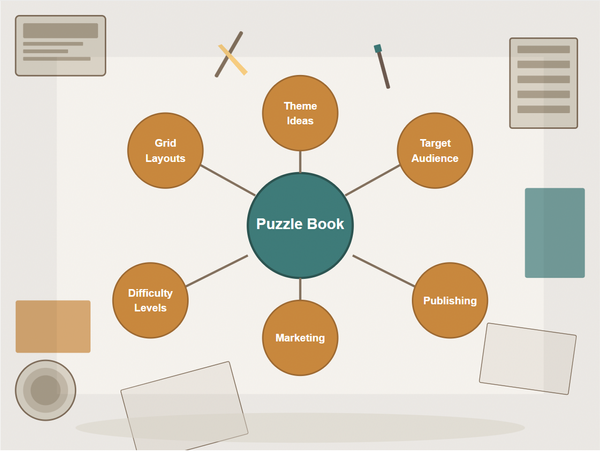Unleashing Your Creative Vision in Puzzle Book Design

Every puzzle book tells a story - not just through its challenges, but through the unique creative touches that make it distinctly yours. As a puzzle designer, you might sometimes wonder how to make your books stand out in the growing digital marketplace. The answer lies not in following trends, but in developing your authentic creative voice.
Finding Your Creative Core
Your creative journey begins with understanding that memorable puzzle books stem from personal insight and imagination. Think about what draws you to puzzle design - is it the joy of crafting "aha!" moments? The satisfaction of guiding solvers through an experience? Your motivation contains clues to your creative direction.
Start by examining puzzle books that inspire you. Notice how their designers made specific choices about:
- Theme integration
- Visual presentation
- Difficulty progression
- Solver engagement
- Overall experience
These elements form the foundation of your creative palette. Your unique combination of these aspects will define your signature style.
Figure 1: A sampling of design elements you can mix and match to create your unique puzzle style. From borders and decorative elements to typography and color choices, each element can be adapted to support your theme and enhance solver engagement.
Crafting Your Creative Framework
Creativity flourishes within structure. The diagram below shows how your creative vision connects and influences three key areas of puzzle book design: theme development, visual identity, and solver experience. Each area contains essential elements that work together to create your unique approach.
Figure 2: The Creative Framework for Puzzle Book Design shows how your central creative vision drives and connects theme, visual presentation, and solver experience. Each outer element (Story, Concept, Layout, Style, Flow, and Difficulty) represents an area where your creative choices shape the final product.
-
Theme Development
- Choose themes that excite you
- List ways to express this theme through different puzzle types
- Plan how themes progress through your book
-
Visual Identity
- Develop a consistent style for instructions
- Design distinctive page layouts
- Create unified visual elements across puzzles
-
Solver Experience
- Map the emotional journey
- Plan difficulty curves
- Include moments of surprise and delight
As you work with these elements, you'll notice patterns emerging that reflect your creative preferences. These patterns will become the building blocks of your unique design approach.
From Vision to Reality
Imagine opening your finished puzzle book. Each page reflects your creative decisions, from the way you present instructions to how you sequence challenges. Your solvers aren't just completing puzzles - they're experiencing your creative vision.
Figure 3: This comparison shows how creative theming transforms a basic word search into an immersive "Deep Sea Discovery" experience. Notice how themed elements like the wave-shaped header, ocean-inspired colors, and decorative elements create a cohesive solving environment while maintaining clear instructions and puzzle accessibility.
Consider how your creative choices might manifest:
- A mystery theme where each puzzle reveals a new clue
- Visual elements that tell a story across pages
- Difficulty progression that feels like a personal journey
- Instructions that speak in your authentic voice
As you develop your creative approach, you'll find yourself naturally moving away from standard formats toward innovations that excite you. This excitement transfers to your solvers, making your books memorable and engaging.
Your Creative Future
Picture yourself six months from now, looking at your collection of published puzzle books. Each one showcases your distinct creative style. Solvers recognize your books by their unique approach, whether it's your clever theme integration, innovative layout designs, or signature puzzle types.
You'll know you're succeeding when:
- Your design decisions feel natural and confident
- Each new book builds on your creative foundation
- Solvers engage with your puzzles exactly as you envisioned
- Your creative voice becomes stronger with each project
Remember, creativity in puzzle design isn't about following trends or using external tools - it's about trusting your creative instincts and building upon them systematically. Your unique perspective is what will make your puzzle books stand out and create memorable experiences for your solvers.
Start today by identifying one creative element you want to develop. As you focus on this aspect, you'll find your creative confidence growing, leading to puzzle books that are uniquely and unmistakably yours.







